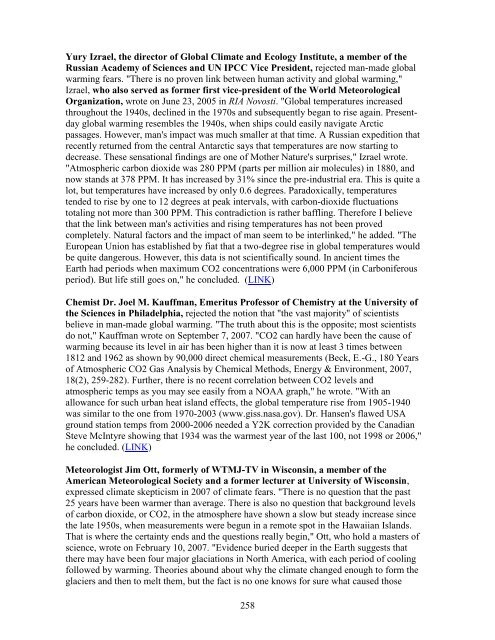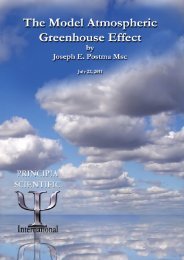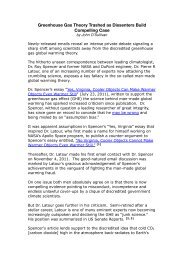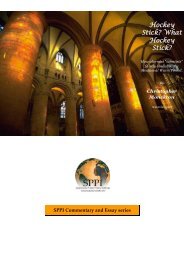Than 1000 International Scientists Dissent Over Man-Made Global ...
Than 1000 International Scientists Dissent Over Man-Made Global ...
Than 1000 International Scientists Dissent Over Man-Made Global ...
You also want an ePaper? Increase the reach of your titles
YUMPU automatically turns print PDFs into web optimized ePapers that Google loves.
Yury Izrael, the director of <strong>Global</strong> Climate and Ecology Institute, a member of the<br />
Russian Academy of Sciences and UN IPCC Vice President, rejected man-made global<br />
warming fears. "There is no proven link between human activity and global warming,"<br />
Izrael, who also served as former first vice-president of the World Meteorological<br />
Organization, wrote on June 23, 2005 in RIA Novosti. "<strong>Global</strong> temperatures increased<br />
throughout the 1940s, declined in the 1970s and subsequently began to rise again. Presentday<br />
global warming resembles the 1940s, when ships could easily navigate Arctic<br />
passages. However, man's impact was much smaller at that time. A Russian expedition that<br />
recently returned from the central Antarctic says that temperatures are now starting to<br />
decrease. These sensational findings are one of Mother Nature's surprises," Izrael wrote.<br />
"Atmospheric carbon dioxide was 280 PPM (parts per million air molecules) in 1880, and<br />
now stands at 378 PPM. It has increased by 31% since the pre-industrial era. This is quite a<br />
lot, but temperatures have increased by only 0.6 degrees. Paradoxically, temperatures<br />
tended to rise by one to 12 degrees at peak intervals, with carbon-dioxide fluctuations<br />
totaling not more than 300 PPM. This contradiction is rather baffling. Therefore I believe<br />
that the link between man's activities and rising temperatures has not been proved<br />
completely. Natural factors and the impact of man seem to be interlinked," he added. "The<br />
European Union has established by fiat that a two-degree rise in global temperatures would<br />
be quite dangerous. However, this data is not scientifically sound. In ancient times the<br />
Earth had periods when maximum CO2 concentrations were 6,000 PPM (in Carboniferous<br />
period). But life still goes on," he concluded. (LINK)<br />
Chemist Dr. Joel M. Kauffman, Emeritus Professor of Chemistry at the University of<br />
the Sciences in Philadelphia, rejected the notion that "the vast majority" of scientists<br />
believe in man-made global warming. "The truth about this is the opposite; most scientists<br />
do not," Kauffman wrote on September 7, 2007. "CO2 can hardly have been the cause of<br />
warming because its level in air has been higher than it is now at least 3 times between<br />
1812 and 1962 as shown by 90,000 direct chemical measurements (Beck, E.-G., 180 Years<br />
of Atmospheric CO2 Gas Analysis by Chemical Methods, Energy & Environment, 2007,<br />
18(2), 259-282). Further, there is no recent correlation between CO2 levels and<br />
atmospheric temps as you may see easily from a NOAA graph," he wrote. "With an<br />
allowance for such urban heat island effects, the global temperature rise from 1905-1940<br />
was similar to the one from 1970-2003 (www.giss.nasa.gov). Dr. Hansen's flawed USA<br />
ground station temps from 2000-2006 needed a Y2K correction provided by the Canadian<br />
Steve McIntyre showing that 1934 was the warmest year of the last 100, not 1998 or 2006,"<br />
he concluded. (LINK)<br />
Meteorologist Jim Ott, formerly of WTMJ-TV in Wisconsin, a member of the<br />
American Meteorological Society and a former lecturer at University of Wisconsin,<br />
expressed climate skepticism in 2007 of climate fears. "There is no question that the past<br />
25 years have been warmer than average. There is also no question that background levels<br />
of carbon dioxide, or CO2, in the atmosphere have shown a slow but steady increase since<br />
the late 1950s, when measurements were begun in a remote spot in the Hawaiian Islands.<br />
That is where the certainty ends and the questions really begin," Ott, who hold a masters of<br />
science, wrote on February 10, 2007. "Evidence buried deeper in the Earth suggests that<br />
there may have been four major glaciations in North America, with each period of cooling<br />
followed by warming. Theories abound about why the climate changed enough to form the<br />
glaciers and then to melt them, but the fact is no one knows for sure what caused those<br />
258





